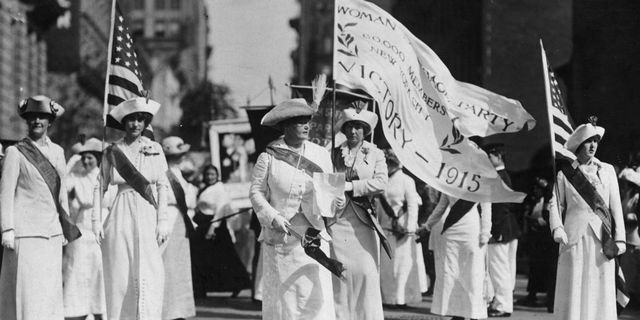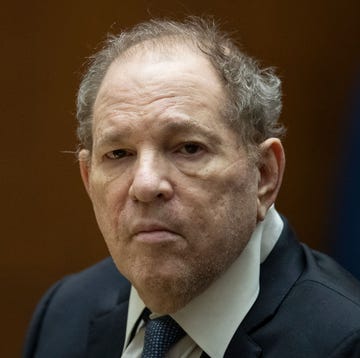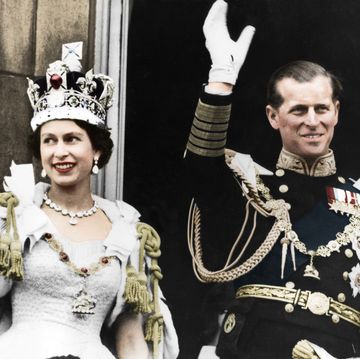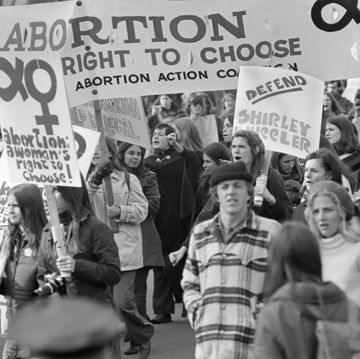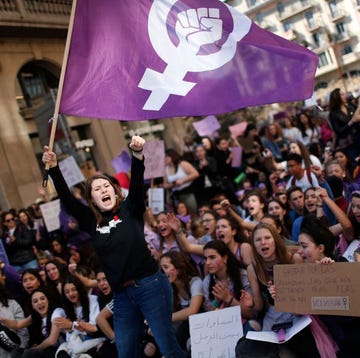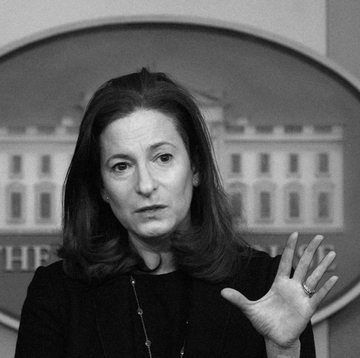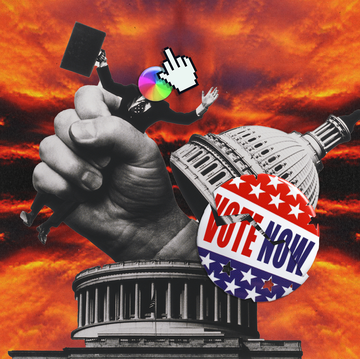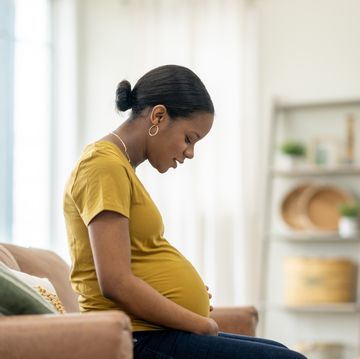Next month, the Supreme Court will make a landmark decision about abortion, deciding if a Texas law that places strict restrictions on abortion providers and clinics in the name of safety has placed an undue burden on pregnant women. The law would result in the closure of three-quarters of abortion clinics in the state and, according to both the American Medical Association and the American College of Obstetricians and Gynecologists, it "does not serve the health of women in Texas but instead jeopardizes women's health by restricting access to abortion providers."
A group of 16 historians who research "the lives of women throughout history" has submitted a brief to the Supreme Court to remind the justices that American men have a pretty rich tradition of passing laws meant to protect women — but that end up controlling them or limiting their rights instead. They argue that these laws are "typically based on gender stereotypes" that effectively curb "women's liberty and autonomy" and treat them as lesser citizens.
Ultimately, these laws have been deemed unconstitutional and discriminatory, but it took America a while to get there. Based on the brief, here's a run-down of some of the discriminatory laws states have passed throughout American history.
1. Married Women Pretty Much Lost All Citizenship Rights in 1769 and Spent Decades Fighting for Them
What the history books don't explicitly tell you is that the American Revolution was mostly meant for white men. A woman's role in society was to marry (preferably at a super young age), at which point she really ceased to have any identity of her own. Husbands were given control of their "wives' bodies, labor, property, and political status" to keep women healthy and safe, "since women were presumed to be the weaker sex and inferior in reason and judgment," the brief explains.
The American colonies established common law in 1769 based on the writings of English judge and politician William Blackstone. This is how Blackstone described a woman's place in society, under a legal doctrine known as "coverture": "By marriage, the husband and wife are one person in law: that is, the very being
or legal existence of the woman is suspended during the
marriage, or at least is incorporated and consolidated into
that of the husband: under whose wing, protection, and
cover, she performs every thing."
It's good the times have changed. If Blackstone could time-warp to present day, his writings about women would not have gotten much pickup beyond the nether regions of 4Chan and Reddit. Sadly, he was very influential and his screeds resulted in denying women the right to vote (which was later reversed with the 19th Amendment in 1920), the right to earn a salary, enter into a contract, or own property. By 1900, married women had gained some control over their earnings and property — though it took until 1979 to repeal laws that allowed a husband to have the final say in household property decisions without his wife's consent.
2. Jury Duty Was Off-Limits or Optional for Women Well Into the 1960s
According to Blackstone's writing, women were not to be in juries because of "defect of sex" — seriously, he made this a legal term with the Latin phrase propter defectum sexus, which, out of context, sounds like a medical term for a venereal disease. You might think that earning the right to vote, which women achieved in 1920, would give women more rights in the public and civil spheres, but nah. In 1927, 29 states had laws barring women from juries because they were considered too delicate to hear courtroom proceedings, and the 19 states that allowed women on juries still made gender-based exceptions for women. Florida didn't allow women to serve on a jury until 1949, and even then they had to "first register their individual willingness at the county courthouse, so that any reluctant woman would be protected from 'the embarrassment of hearing filthy evidence,'" the brief notes. In 1961, Florida's law was challenged in the Supreme Court by Gwendolyn Hoyt, a woman who was found guilty by a jury of all men for murdering her abusive husband. The Court sided with Florida and Justice John Marshall Harlan II declared that a "woman is still regarded as the center of home and family life." It wasn't until 1973 when women could serve in juries in every state.
3. Women Protected From Long Work Hours Because They Are Weaker
What did society scramble to do in the late 1800s with women who ventured beyond their domain — the house — and into the workplace? Limit their time away from home, which was done for their own benefit. Regulating factory work conditions, in general, did protect millions of women from being overworked or facing workplace abuses. But these protections did not apply to men, all but ensuring that women in male-dominated fields would stay a minority. In 1908, the Supreme Court ruled that an Oregon law limiting female factory and laundry worker hours was totally valid, but limiting male hours was not, because, according to the brief, "women's health was more precarious than that of men; that women had household as well as wage-earning duties; and that the nation had a stake in women's well-being because of women's roles as present or future mothers." Good to know that, long before the abortion debate, America's always been thinking of unborn children first.
Men eventually got legal labor protection under the New Deal reforms in the 1930s, but sex-specific labor laws continued to be a thing until 1969, five years after the passage of the Civil Rights Act.
4. Women Were Barred from Certain Jobs and Working at Night Too
By 1917, all but nine states had passed sex-specific labor laws that either barred women from certain type of work (in Texas, any factory where there many be "any influence,
practices or conditions calculated to injuriously affect
the morals" of a woman, for example), or prohibited them from working at night or required certain work conditions, because America is an overprotective dad. What's even more messed up about the laws, however, is how they really only served to protect white women or women who weren't competing directly with men. New York, for example, "did not regulate women's night work in service jobs not desired by men, including in hotels, restaurants, and cabarets, despite the evident danger to their morals in these locations." If you were an immigrant or woman of color, you were screwed: "Cannery workers, generally immigrant women, were routinely exempted from night work restrictions; domestic servants, many of them African-American, and particularly vulnerable to exploitation, did not benefit from protection."
5. Bartending Was Deemed Immoral
By 1950, nearly half of the states in the U.S. had placed restrictions prohibiting or limiting when women could bartend because it was considered an immoral profession for women. Michigan, for example, in 1945 passed a law that said towns with populations over 50,000 could not have female bartenders unless they were "the wife or daughter" of the bar's owner. Valentine Goesaert, a bar owner in Dearborn, Michigan, sued the state because under its law she was not allowed to bartend at her own damn bar. The Supreme Court took up the case and in 1948 ruled against Goesaert, deciding that the dispensing of alcohol was potentially morally and socially compromising for women. The decision was overruled in 1976.
6. Pregnant? No Work for You
By 1970, America had made a lot of progress (thank you, civil rights activists), but the old-school thinking that women are weak and feeble led to discrimination against pregnant women. Thirty-five states had laws saying pregnancy women were ineligible for unemployment insurance, and thousands of teachers across America were told that they had to take leave without pay, or had to stop teaching in the classroom by the fourth or fifth month of pregnancy. The practice wasn't outlawed until the Pregnancy Discrimination Act of 1978.
7. Marital Rape Was Not a Thing
Common law followed the rules established by English jurist Sir Matthew Hale, who in 1736 wrote that upon marriage, a wife "hath given up herself in this kind to her husband, which she cannot retract." Feminist activists had been arguing for the criminalization of marital rape back in the 19th century, but it wasn't until the 1970s when the movement gained traction and states began to outlaw spousal rape. It took until 1993 for marital rape to become illegal in all 50 states, but 13 states still make exceptions for marital rape, as if it's less awful than rape by a non-spouse.
8. All Those Laws that Actually ~Would~ Protect Women...? Haha, No
The brief doesn't mention a host of laws that men have objected to, or have failed to consider for years, that actually would protect women. This includes the fight to legalize abortion, to acknowledge sexual harassment exists by giving it a legal definition and then to let women sue for it in court, and the long battle to make birth control accessible to women, to name a few.
Follow Prachi on Twitter.

Prachi Gupta is an award-winning journalist and former senior reporter at Jezebel. She won a Writers Guild Award for her investigative essay “Stories About My Brother.” Her work was featured in The Best American Magazine Writing 2021 and has appeared in The Atlantic, The Washington Post Magazine, Marie Claire, Salon, Elle, and elsewhere. PrachiGupta lives in New York City.
